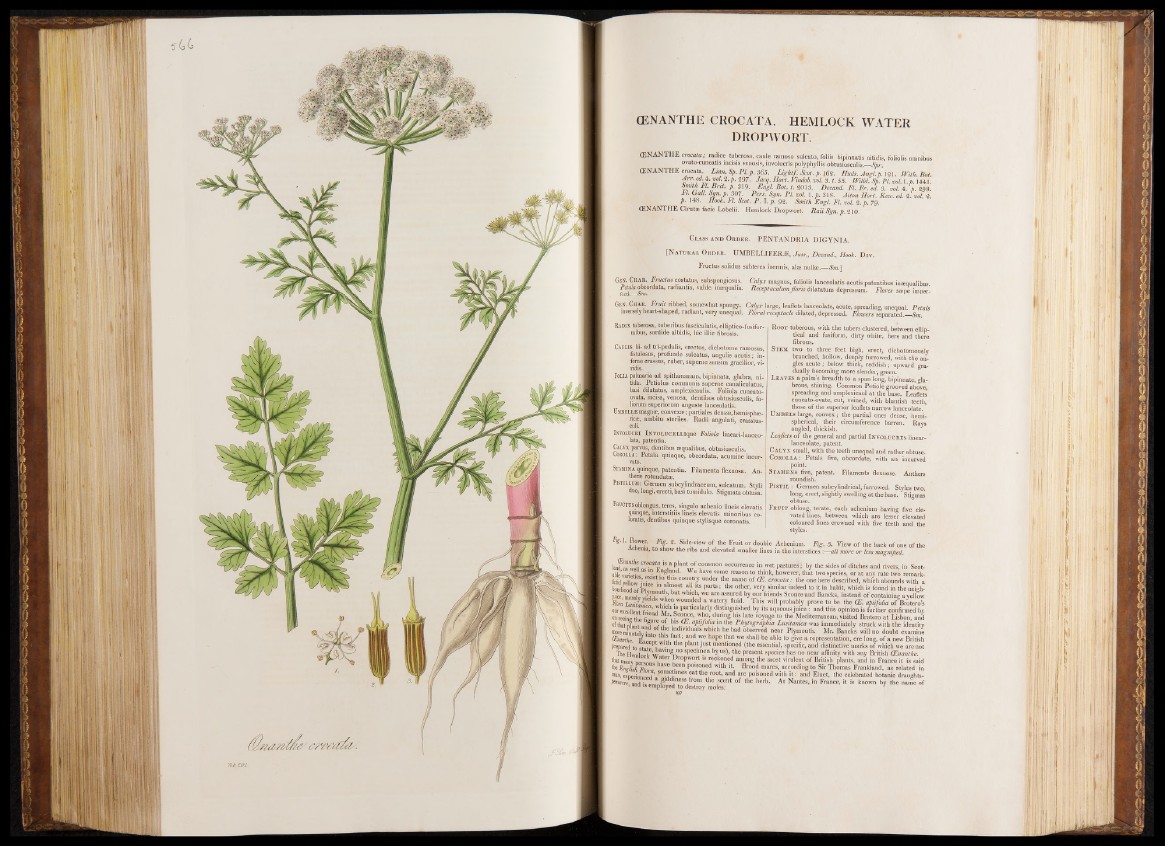
(ENANTHE CROCATA. HEMLOCK WATER
DROPWORT.
(ENANTHE crocata; radice tuberosa, caule ramoso sulcato, foliis bipinnatis nitidis, foliolis omnibus
ovato-cuneatis incisis venosis, involucris polyphyllis obtusiusculis.__Spr.
(ENANTHE crocata. Linn. S p .P l.p . 365. L ig h tf Scot. p. J62. Huds.Angl.p. 121. With. Bot.
Arr-ed.4. vol. 2. p. 297. Jacq. Hort. Vindqb. vol. 3. t. 55. Willd. Sp. PI. vol. 1.». 1441.
P- 319- Engl. Bot. t. 2013. Decand. Fl. Fr. ed. 3. vol. 4. p. 298.
FI Gall. Sm .p . 307. P a 's Syn. PI. vol. 1./>.S18. Aiton Hort. Kav. ed. 2. vol. 2.
p. 148. Hook. Fl. Scot. P . I. p. 92. Smith Engl. Fl. vol. 2. p. 79.
(ENANTHE Cicutae facie Lobelii. Hemlock Dropwort. Raii Syn. p. 210.
Class a nd Ord er. PENTANDRIA DIGYNIA.
[N atural Order. UMBELLIFERÆ, Juss., Decand., Hook. D iv .
Fructus solidus subteres inermis, alæ nullæ.— Sm.]
Gen. Char. Fructus costatus, subspongiosus. Calyx magnus, foliolis lanceolatis acutis patentibus inasqualibus
’ ntia> ^ ^ mffiqualla- dilatatum depressum. Flores s®pe imper-
Gen. Char. Fruit ribbed, somewhat spongy. Calyx large, leaflets lanceolate, acute, spreading, unequal. Petals
inversely heart-shaped, radiant, very unequal. Floral receptacle dilated, depressed. Flowers separated.__Sm.
Radix tuberosa, tuberibus fasciculatis, elliptico-fusifor-
niibus, sordide albidis, hie illic fibrosis.
Caulis bi- ad tri-pedalis, erectus, dichotome ramosus,
fistulosus, profunde sulcatus, angulis acutis; inferne
crassus, ruber, superne sensim graciiior, vi-
ridisi
Folia palmaria ad spithamseam, bipinnata, glabra, nitida.
Petiolus communis superne canaliculatus,
basi dilatatus, amplexicaulis. Foliola cuneato-
ovata, incisa, venosa, dentibus obtusiusculis, fo-
liorum superiorum anguste lanceolatis.
Umbelle magme, convex®; partiales densae, hemisphte-
rieffi, ambitu steriles. Radii angulati, crassius-
culi.
Involucri iNVOLUCELLique Foliola lineari-lauceo-
lata, patentia.
Calyx parvus, dentibus asqualibus, obtusiusculis.
Corolla : Petala quinque, obcordata, acumine incur-
Stamina quinque, patentia. Filamenta flexuosa. Anther
® rotundat®.
Pistillum: Germen subcylindraceum, sulcatum. Styli
duo, longi,erecti, basi tumidulo. Stigmata obtusa.
Fructus oblongus, teres, singulo achenio lineis elevatis
quinque, interstitiis lineis elevatis minoribus co-
loratis, dentibus quinque stylisque coronatis.
Root tuberous, with the tubers clustered, between elliptical
and fusiform, dirty white, here and there
fibrous.
Stem two to three feet high, erect, dichotomously
branched, hollow, deeply furrowed, with the angles
acute; below thick, reddish; upward gradually
becoming more slender, green.
L eaves a palm’s breadth to a span long, bipinnate, glabrous,
shining. Common Petiole grooved above,
spreading and amplexicaul at the base. Leaflets’
cuneato-ovate, cut, veined, with bluntish teeth,
those of the superior leaflets narrow lanceolate.
Umbels large, convex; the partial ones dense, hemispherical,
their circumference barren. Rays
angled, thickisb.
Leaflets of the general and partial I nvolucres linear- '
lanceolate, patent.
Calyx small, with the teeth unequal and rather obtuse.
Corolla: Petals five, obcordate, with an incurved
point.
Stamens five, patent. Filaments flexuose. Anthers
roundish.
P ist il : Germen subcylindrical, furrowed. Styles two,
long, erect, slightly swelling at the base. Stigmas
obtuse.
Fru it oblong, terate, each achenium having five elevated
lines, between which are lesser elevated
coloured lines crowned with five teeth and the
styles.
Pig. 1. Flower. Fig. 2. Side-view of the Fruit or double Achenium. Fig. 3. View o f the back of one of the
Achema, to show the ribs and elevated smaller lines in the interstices .—all more or less magnified.
land cro?at“ is a P]ant of common occurrence in wet pastures; by the sides of ditches and rivers, in Scot-
able’virUL. aS §5 • We have some reason to think, however, that two species, or at any rate two remarkfetid
vpllm • aX1S^10 1 1S C0U"tl7 un^er the name of CE. crocata: the one here described, which abounds with a
bourhonrf SIP! m . °St , . ,lts parts ’ the °ther, very similar indeed to it in habit, which is found in the nei*di-
juice mprpi,, , / u 0U u ^Ut wh,ch, we are assured by our friends Sconce and Bancks, instead of containing a yellow
Flora Lusitllir* J*.h®n.woun?ed. a.wa*e7 fluid. This will probably prove to be the CE. apiifolia of Brotero’s
our excellent frmnTiu c Partlcularly distinguished by its aqueous juice : and this opinion is further confirmed by
on seeintr the . C<^ ? e’ his late voyage to the Mediterranean, visited Brotero at Lisbon, and
of that plant and I B opiifolia in the Phytographia Lusitamca was immediately struck with the identity
more minSv *ndtlvldu.als wJ,ch h,e had observed near Plymouth. Mr. Bancks will no doubt examine
(Enanthe j/v ► -u u ’ a,nd ^0Pe lhat we shall be able to give a representation, ere long, of a new British
Prepared to W- t ie plant Just mentioned (the essential, specific, and distinctive marks of which we are not
The H e m l J S W J 10 sPe“ men by us), the present species has no near affinity with any British (Enanlhc.
that ,,m n v , ter propwort is reckoned among the most virulent of British plants, and in France it is said
the K W hS have S“ "' P0150,11“ 1 mth Broo? mures, according to Sir Thomas Frankland, as related in
man, exDerienrwi ’ ®°^®Vmes ®at die root, and are poisoned with i t : and Elnet, the celebrated botanic draughts-
Pwtacre. and is t le ,SCent of the herb. At Nantes,’ ana is employed to destroy moles: in France, it is known by- 'the name of
197